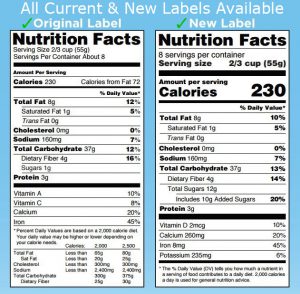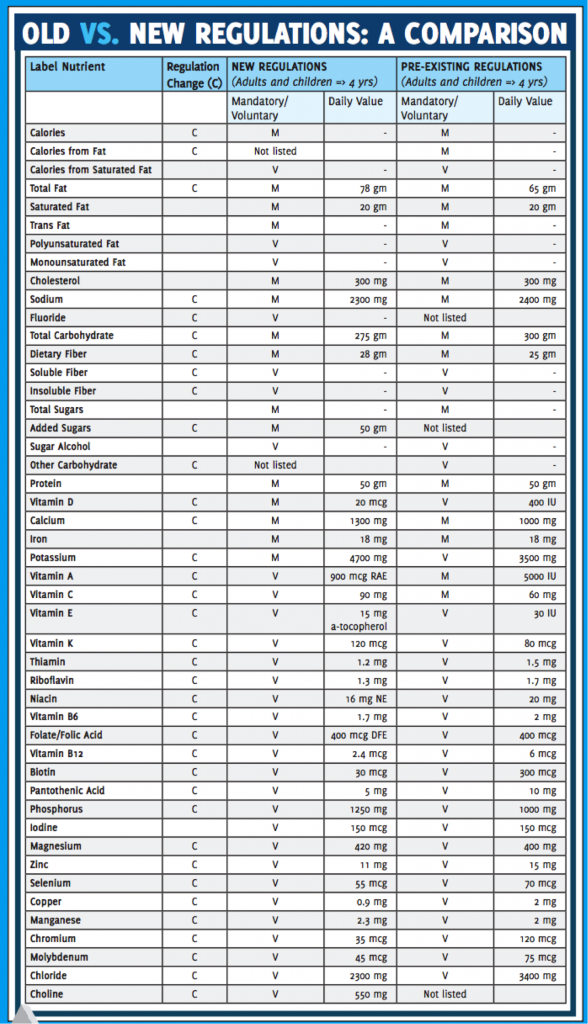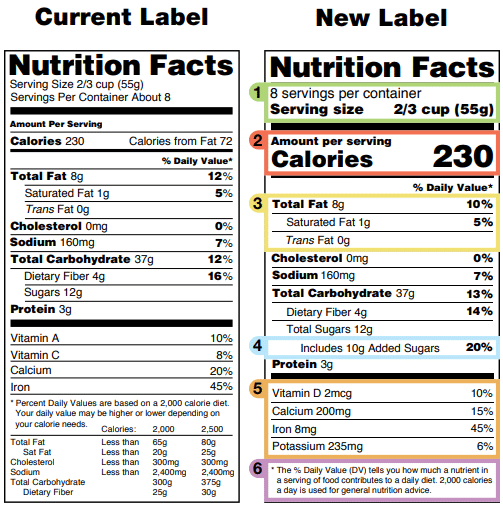2020 FDA Regulations for Food Labeling: Are You Compliant?

Get FDA Compliant for 2020 with LabelCalc
2020 FDA Regulations for Food Labeling: Are You Compliant?
According to new FDA regulations regarding food labeling for food manufacturers: companies exceeding $10 million in revenue must comply with new changes by Jan 1, 2020. Companies below that revenue mark or single supply manufacturers of items such as sugar and honey have until Jan 2021.
Today we will take a look at the changes to the nutrition facts label per the U.S. Food and Drug Administration and how you can verify if your current label is compliant or may need updating.
Visually, one can begin to derive the most obvious changes to the original nutrition label formatting. The calories are highlighted in bold and in larger font and “added sugars” have become a new category all of their own in the latest version of the FDA food label. Looking slightly further down the nutrition facts label, one can observe that the foot note has been changed regarding the advice and daily values being based on a 2,000 calorie diet.
So Why All the Changes?
With the new regulations in place, it’s easy to wonder why these changes were so necessary that the FDA published the updated label as a required for all manufacturers in the food industry.
Let’s go through the changes one by one and discover the “why” behind each update.
Serving Sizes
At the very top of the label, you will notice that the serving size, as well as servings per container have increased in font size. The serving size amount has also been printed in bold for easy reading.
According to the FDA, there was some discrepancy between the appropriate serving size amount listed on product packaging and the actual size normally consumed in society today. For example, the single serving size for ice cream is typically listed as ½ cup. This amount has been updated to ¾ cup to reflect the true amount of ice cream typically consumed in one sitting.
Reflecting the appropriate amount consumed helps the consumer understand the true caloric and nutrient value of their typical serving versus the lesser, previously listed amount.
Total Fat and Calorie Content Updates
One of the most prominent updates of the new food labeling regulations released by the FDA is found on the calorie line. The font for calories has been significantly enlarged as well as emboldened for first-glance reference. Caloric values can be very simply understood without having to look very deeply into the food label.
Calories from fat, if you haven’t noticed, has been completely removed from the FDA nutrition facts label completely. The thought behind the update is to inadvertently call attention to the type of fat being consumed. According to the FDA, the calories from fat are not as important as the fat type that is being consumed.
Added Sugars
A new category has emerged on the updated FDA food label: added sugars. An added sugar is a sugar type that doesn’t occur naturally within the product and has been added to sweeten the packaged food item. Added sugars can include but aren’t limited to syrups, types of actual sugars as well as honey and even fruit juices.
The logic behind this change, according to the FDA, is that it becomes increasingly difficult to stay within the daily recommended caloric range if more than 10% of one’s diet is derived from added sugars. Especially when one’s diet consists of a high volume of packaged food products.
Daily Value Percentage Changes

The criteria for daily value percentages for food labeling has changed on the new updated 2020 label.
Not only have the actual nutrients required on the new nutrition facts panel changed, new regulations concerning the way they are listed have changed as well.
As of 2020, the daily value % of any vitamin or mineral listed is not to exceed 100%. Vitamins A & C have been completely removed from the updated food label format. This is due to a lack of relevance considering deficiency is very rare in this day and age. In their place, potassium and iron have been listed as required nutrients on the new label. This change reflects the fact that the average American does not consume sufficient amounts of either nutrient on a regular basis.
Dietary Fiber and Sodium
These changes also include the updated daily recommended values for dietary fiber and sodium. Sodium, for example, had a recommended DV (daily value) of 2,400 mg per day. As you can see pictured above, the new value is 2300 mg. Accompanying health claims such as “low sodium” has criteria surround the use of the claim on product packaging. In order for a food package to bear that claim, the total sodium percentage per serving must be 5% or less of the recommended DV of 2300 mg. These changes stem from a larger movement per the WHO (World Health Organization) in a global effort to improve heart health worldwide.
Dietary fiber also received a change in recommended daily value. Previous recommendations per the USDA were approximately 25 g of daily fiber per day. This amount has been increased to 28g. Dietary fiber contributes to overall digestive health and foods containing significant amounts of dietary fiber tend to be heart healthy and micronutrient dense (full of vitamins) which is in line with the effort to improve public health as well.
Footnote
Last but not least, the very bottom of the label was redone to draw attention to the meaning behind daily value percentages. The new text explains the daily value percentage as it pertains to meeting nutrient need according to the advisement of a 2,000 calorie diet. Emphasis previously was placed on the issue of caloric consumption based upon one’s personal needs.
Compliance
So what does this mean for you, the food manufacturer? Does your food labeling service or software require an update? And will you be compliant in time for the 2020 FDA regulations for food labeling rolling out in just a short period of time?
Nutrition analysis and labeling software that is cloud based and receives regular updates, such as the LabelCalc software, can ensure your FDA compliance. 2020 formatting has already been integrated into the database and is available for use now.
No need to wait til the last minute to become complaint, ensure your product is ready and updated today with LabelCalc.


